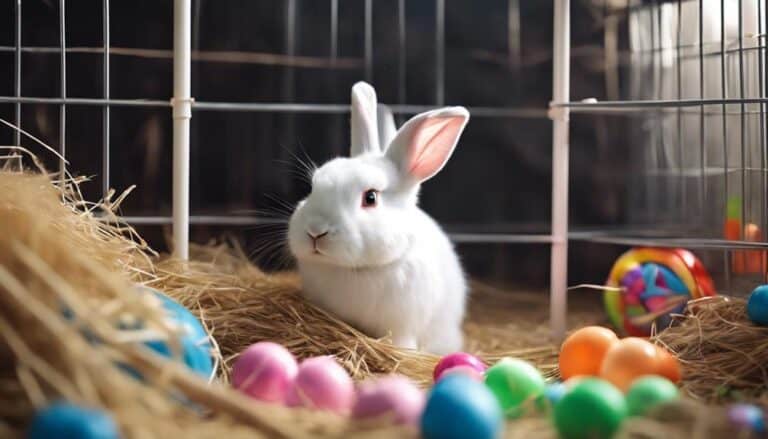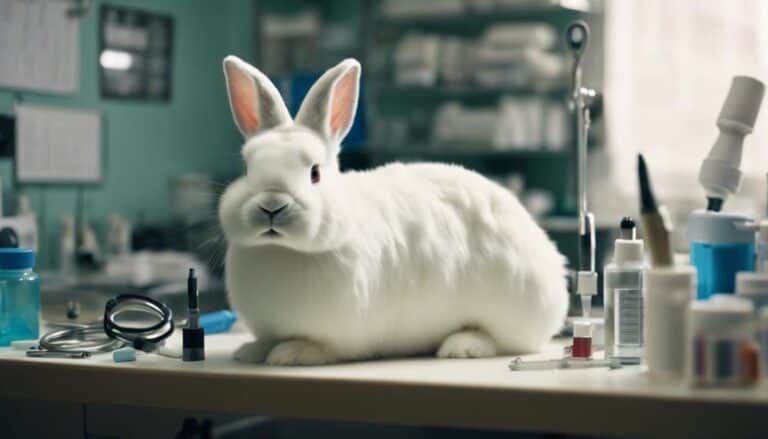When it comes to grooming your pet bunnies, exploring through their fluffy coats can be like untangling a delicate puzzle. Careful handling and the right tools are key to ensuring a safe grooming experience.
From nail clipping techniques to maintaining their fur, each step contributes to your bunny's well-being. As you set out on this grooming journey, there are essential tips and practices that can make the process smoother and more enjoyable for both you and your furry companion.
Contents
- 1 Key Takeaways
- 2 Proper Tool Selection for Bunny Grooming
- 3 Handling and Restraint Techniques for Bunnies
- 4 Brushing and Detangling Bunny Fur
- 5 Safe Ear Cleaning Practices for Bunnies
- 6 Nail Clipping Tips for Bunnies
- 7 Importance of Regular Health Checks
- 8 Handling Mats and Tangles in Bunny Fur
- 9 Bathing Dos and Don'ts for Bunnies
- 10 Frequently Asked Questions
- 11 What Are Some Key Tips for Safely Grooming My Pet Bunny?
- 12 Conclusion
Key Takeaways
- Use gentle grooming tools and products suitable for bunnies' delicate fur.
- Practice proper handling and restraint techniques to ensure your bunny's safety and comfort.
- Regularly groom your bunny from head to tail to prevent tangles and promote a healthy coat.
- Maintain good hygiene by cleaning ears, eyes, and trimming nails with caution and care.
Proper Tool Selection for Bunny Grooming
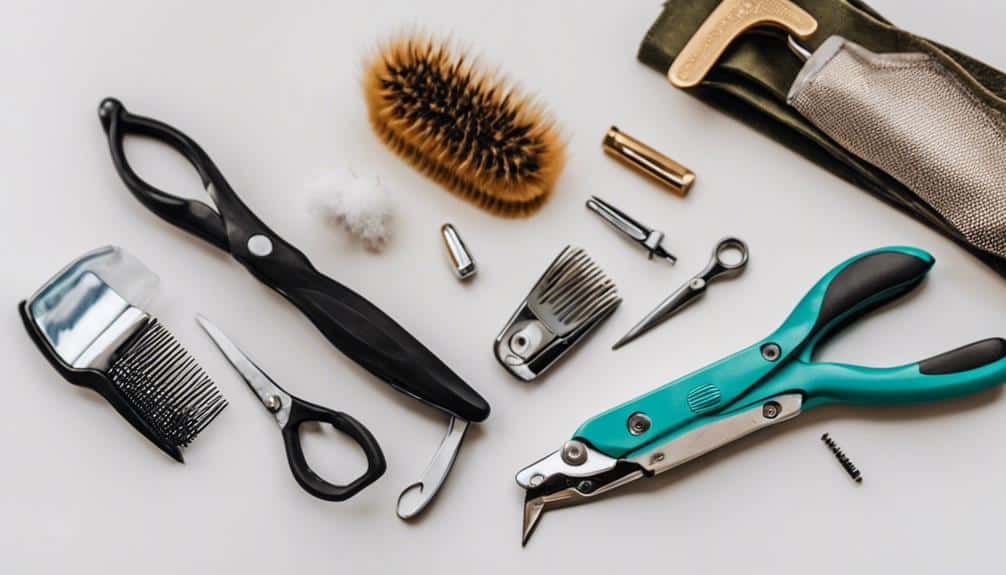
When grooming your pet bunny, selecting the appropriate tools is essential for maintaining their fur health and overall well-being. Slicker brushes are ideal for removing loose fur and preventing matting in rabbits, guaranteeing their coats remain smooth and knot-free.
Metal combs are essential for detangling and grooming bunnies with different hair lengths, while double metal combs work well for thorough grooming sessions and removing stubborn tangles effectively.
Flea combs are useful in detecting and eliminating fleas or debris from your bunny's coat, promoting a clean and healthy fur environment. Additionally, rubber brushes or mitts provide a gentle option for surface brushing and massaging your rabbit's skin during grooming sessions, enhancing blood circulation and overall skin health.
Handling and Restraint Techniques for Bunnies
To safely handle and restrain your bunny, it's important to properly support their hindquarters to prevent any potential injury or discomfort. When holding your rabbit, keep these tips in mind:
- Avoid picking up a rabbit by its ears: Rabbit ears are sensitive and can tear easily, causing pain and potential injury.
- Use a gentle but secure grip: When restraining your rabbit, make sure you apply gentle pressure to prevent escape or harm.
- Approach your rabbit from the front: By approaching from the front, you reduce the risk of startling your bunny, making the handling process smoother and less stressful.
Remember to handle your bunny with care and respect their boundaries. These techniques will help create a safe and comfortable environment for both you and your furry friend.
Brushing and Detangling Bunny Fur
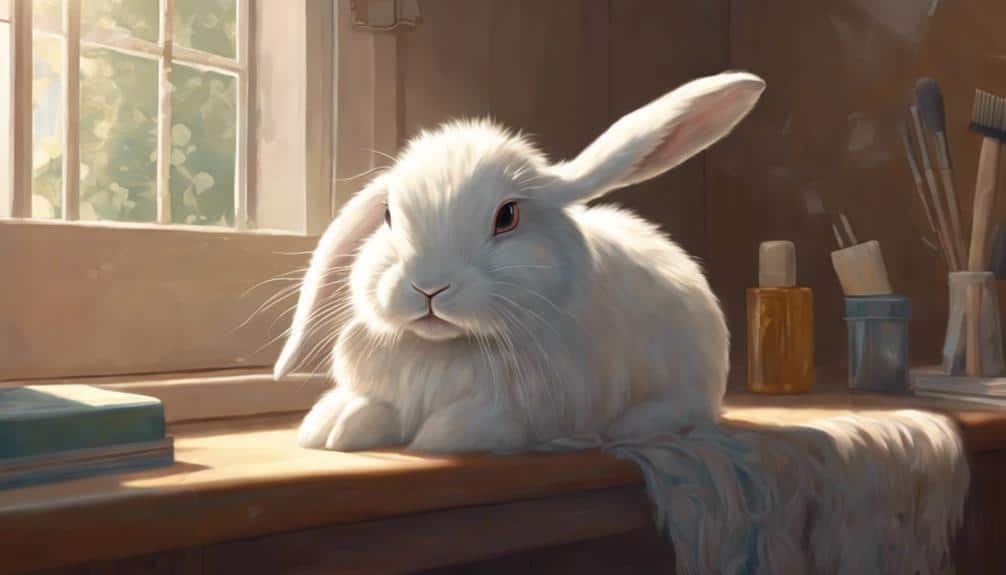
Gently brushing and detangling your bunny's fur is essential for maintaining their coat health and overall well-being. To effectively care for your rabbit's fur, use a slicker brush or a metal comb designed for small animals. Begin by brushing from the top of the head and move downwards towards the tail, making sure you cover the entire body to prevent tangles. It's important to approach this task with patience and gentleness, especially when dealing with mats or tangles to prevent any discomfort for your bunny.
Regular brushing isn't only beneficial for preventing fur matting but also helps reduce the risk of hairballs in rabbits, promoting their digestive health. Pay close attention to areas prone to matting, such as the armpits, belly, and behind the ears, where tangles are more likely to form. By incorporating brushing and detangling into your bunny's grooming routine, you contribute to their well-being and make sure they've a healthy and shiny coat.
Safe Ear Cleaning Practices for Bunnies
Regularly checking and cleaning your bunny's ears is essential, especially for lop-eared rabbits prone to ear infections due to their unique ear structure. To guarantee your bunny's ear health, follow these safe ear cleaning practices:
- Consult a Vet: Before starting any ear cleaning regimen, consult a vet to learn the proper technique and tools to use. They can recommend a vet-approved cleaning solution suitable for your bunny.
- Weekly Ear Checks: Perform weekly checks to catch any wax build-up or signs of infection early. Prevention is key to maintaining healthy ears.
- Gentle Tools and Proper Technique: Use gentle tools like cotton balls or pads to clean your bunny's ears. Always handle with care and follow the vet's guidance on the proper technique to prevent injuries or infections.
Nail Clipping Tips for Bunnies
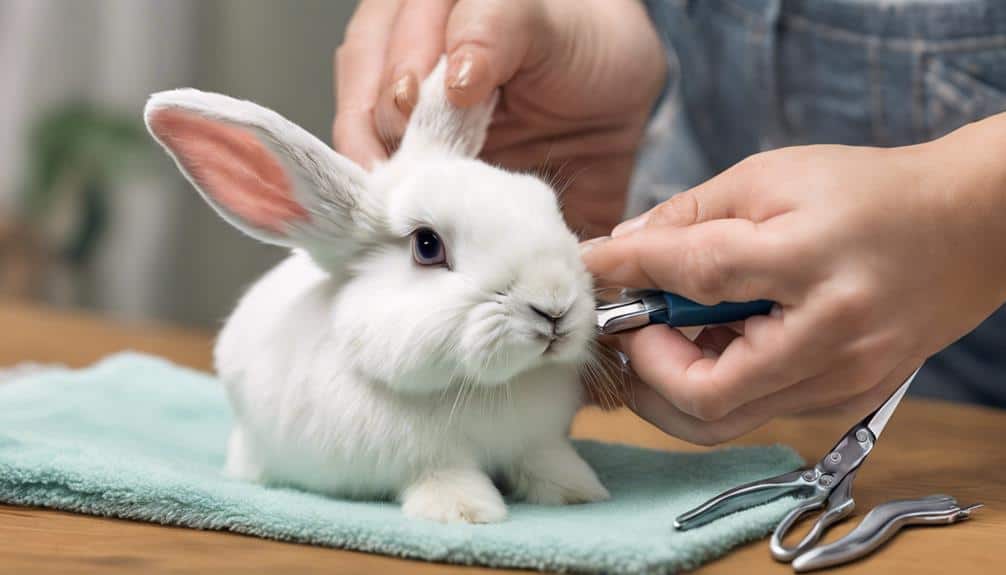
When trimming your bunny's nails, it's crucial to maintain proper length to prevent discomfort and overgrowth. Use small animal nail clippers for precise and safe trimming, being cautious of the quick to avoid bleeding.
Remember to have styptic powder on hand in case of any accidents to stop the bleeding quickly.
Proper Nail Length
To maintain the health and comfort of your pet bunny, it's essential to trim their nails every 4-6 weeks to make sure proper nail length and prevent issues. When clipping your rabbit's nails, consider the following:
- Use rabbit nail clippers designed for small animals to ensure safe and effective trimming.
- Be cautious not to cut the quick, which is the blood vessel inside the nail, to avoid bleeding and discomfort for your bunny.
- After a successful nail trimming session, reward your bunny with treats and positive reinforcement to create a positive association with the grooming process.
Handling Nail Clippers
Using the proper technique with small animal nail clippers designed for rabbits is essential for safely and effectively trimming your bunny's nails. Avoid cutting into the quick, which houses the blood vessel in the nail, by trimming small amounts at a time to prevent bleeding. Keep styptic powder nearby to stop any bleeding if you accidentally cut the quick.
Remember to reward your rabbit with treats and praise after each successful nail trimming session to create a positive experience. For baby bunnies, consider using an emery board to file their nails until they're large enough for regular nail clippers to prevent injury.
Always be cautious and attentive to avoid causing any bleeding while grooming your bunny.
Importance of Regular Health Checks
Regularly scheduling health checks for your pet bunny is essential for their overall well-being and early detection of potential health issues. Here are some key reasons why regular health checks are vital for your furry friend:
- Early Detection: Regular health checks help in catching any potential health issues early on, allowing for prompt treatment and better management.
- Monitoring Changes: Observing changes in behavior, appetite, and activity levels during health checks can provide valuable insights into your bunny's health status.
- Overall Well-being: Health checks contribute very much to maintaining the overall well-being and quality of life of your pet bunny.
Handling Mats and Tangles in Bunny Fur
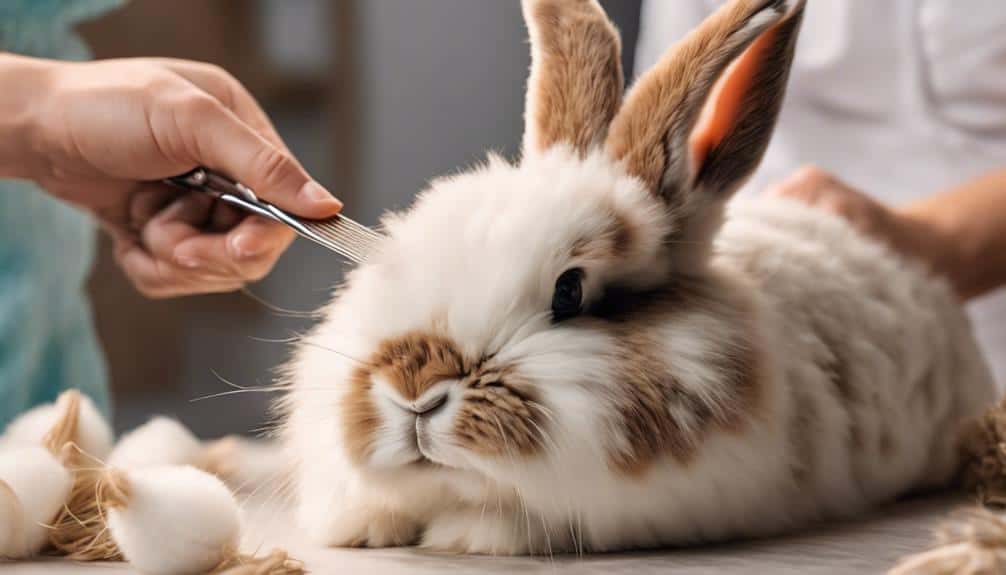
When grooming your pet bunny, it's important to know how to properly handle mats and tangles in their fur to guarantee their comfort and well-being. To address mats and tangles, consider using a mat splitter or rake to gently tease them out. Avoid cutting mats with scissors as this can inadvertently lead to injuring your bunny's delicate skin. If the mats are severe or close to the skin, seeking professional help is advisable to make safe removal.
Regular grooming plays a critical role in preventing mats and tangles from forming in your bunny's fur. When detangling mats, exercise patience and use gentle techniques to avoid causing any discomfort to your furry friend. Remember, a gentle approach and regular maintenance are key to keeping your bunny's coat in top condition and promoting their overall well-being.
Bathing Dos and Don'ts for Bunnies
For ideal bunny care, it's important to understand the dos and don'ts of bathing these delicate pets. When it comes to bathing bunnies, here are some key tips to keep in mind:
- Avoid Full Baths: Bunnies should generally not be bathed unless absolutely necessary to prevent stress and health risks associated with wet fur.
- Spot Cleaning: Use a damp cloth for spot cleaning instead of full baths to maintain your bunny's cleanliness without the need for a full bath.
- Thorough Drying: After bathing, make sure your bunny is thoroughly dried to prevent respiratory infections and hypothermia, which can be harmful to their health.
Frequently Asked Questions
How Do You Groom a Rabbit Effectively?
When grooming a rabbit effectively, remember to use gentle brushing techniques to prevent matting, trim nails carefully, clean ears regularly, consider bathing sparingly, maintain fur health, attend to eye care, monitor dental health, handle stress delicately, address shedding season, and use appropriate grooming supplies.
How Do You Safely Clean a Rabbit?
When cleaning a rabbit, handle with care. Use safe products and proper tools to avoid health hazards. Take precautionary measures like a gentle approach, avoiding water in ears. Reduce stress, follow bathing methods, guarantee proper drying, and maintain hygiene.
How Do You Groom an Indoor Rabbit?
To groom an indoor rabbit safely, brush gently, trim nails carefully, check for fur matting, handle shedding season with care, clean ears and eyes regularly, use proper bathing methods sparingly, maintain dental care, select appropriate grooming tools, and manage handling stress effectively.
Which Types of Grooming Are Essential for Rabbits?
When grooming your pet bunny, it is crucial to brush fur regularly, trim nails to prevent injuries, clean ears to avoid infections, check teeth for health, inspect eyes, and monitor shedding seasons for mat removal.
What Are Some Key Tips for Safely Grooming My Pet Bunny?
Regular grooming is essential for the importance of bunny grooming. Brushing your pet helps prevent hairballs and keeps their fur clean. Trimming their nails is also crucial to prevent overgrowth and potential injury. Regularly check their ears and teeth too, as these can be indicators of overall health.
Conclusion
To sum up, remember that grooming your pet bunny isn't only crucial for their health and well-being but can also strengthen the bond between you and your furry friend.
By using the right tools and techniques, handling them with care, and seeking professional help when needed, you can guarantee a safe and enjoyable grooming experience for your beloved bunny.
So, keep up with regular grooming sessions to keep your bunny happy, healthy, and looking their best!





